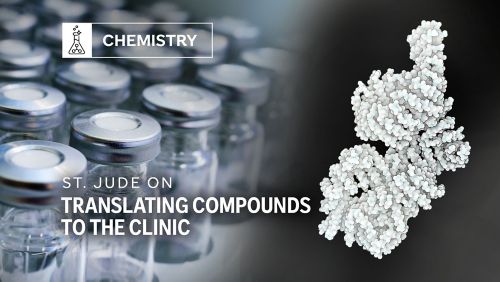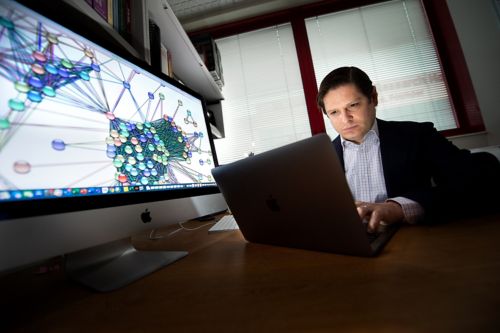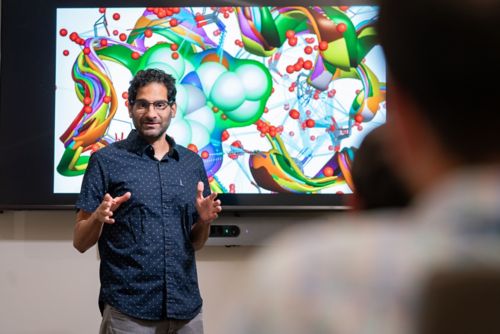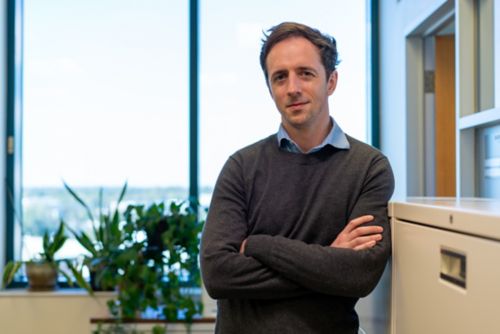St. Jude Family of Websites
Explore our cutting edge research, world-class patient care, career opportunities and more.
St. Jude Children's Research Hospital Home

- Fundraising
St. Jude Family of Websites
Explore our cutting edge research, world-class patient care, career opportunities and more.
St. Jude Children's Research Hospital Home

- Fundraising
The circuitous path from chemical compound to clinical trial

Investigators at St. Jude are moving promising chemical compounds from the lab to the clinic through translational research.
Reports show that it takes hundreds of millions of dollars and about 10 years for a drug to progress from preclinical trials to being approved for patient use. While timelines and budgets vary widely depending on the trial design, therapeutic area and disease, those numbers still do not account for the years — decades even — of research that precedes clinical development.
At St. Jude and in research labs worldwide, chemists, molecular biologists and other scientists study how certain molecules behave and interact. The primary goal of this discovery work is to find a target of interest for specific, often rare, forms of cancer. However, many of these identified targets are considered “undruggable,” either because of their structure or because they cause multiple or systemic effects that would make targeting them directly too toxic.
“It would be a great career in translational cancer medicine if you could make even one contribution that made a difference to patient outcomes,” said Paul Geeleher, PhD, Department of Computational Biology. “The entire process of getting to a new compound, a repurposed drug or a new drug combination is very difficult, with numerous points of failure.”
Indeed, out of potentially billions of compounds that a scientist may test through high-throughput screening or virtual screening using computer-aided design, only about 100 to 1,000 are selected and evaluated experimentally in the lab. Those that look promising must effectively reach tumor cells, show a statistically significant effect in preclinical trials and go through additional drug optimization — and that is just to make it to clinical trials. Once in clinical trials, only a small percentage of novel drugs produce meaningful safety and efficacy results.
Pediatric studies present additional obstacles. They typically involve fewer patients due to recruitment challenges and smaller overall patient populations. Pediatric clinical research also requires protocol considerations to accommodate different developmental stages; plus, some medicines simply work differently in children than in adults.

Adam Durbin, MD, PhD, Department of Oncology, is leading translational research on the targets EP300/CBP in pediatric cancer.
“You have to be creative in how you design pediatric trials,” said Adam Durbin, MD, PhD, St. Jude Department of Oncology, a physician-scientist who treats patients with neuroblastoma. “Researchers throughout this institution have done that, making meaningful findings from small numbers of patients.”
Advancing treatments, solving mysteries
Sometimes, creative thinking helps uncover a new purpose for an existing therapy. For example, Durbin and team discovered that targeting the bromodomain region of EP300 and CBP, which are essential for gene regulation in Group 3 medulloblastoma cells, causes a slowing of tumor growth. With that understanding, they examined inobrodib, a small molecule bromodomain inhibitor under investigation for multiple myeloma, acute myeloid leukemia and peripheral T cell lymphomas.
However, inobrodib did not clear the blood-brain barrier. To get over this hurdle, Durbin and team collaborated with Martine Roussel, PhD, Department of Tumor Cell Biology; Jun Qi, PhD, Dana-Farber Cancer Institute; and Ernst Schonbrunn, PhD, Moffitt Cancer Center, to create a novel version of the drug that improved selectivity and efficacy in targeting EP300/CBP in Group 3 medulloblastoma cells. In a paper published in Nature Communications, the group reported this new compound and has since continued to study and optimize it.

Anang Shelat, PD, Department of Chemical Biology & Therapeutics explores potential treatment paths through compound screening and mechanistic analysis.
Another way scientists discover novel treatment options is to leverage advanced tools and technology to find weaknesses or deficiencies that warrant further study. The lab of Anang Shelat, PhD, Department of Chemical Biology & Therapeutics, explores potential treatment paths through compound screening and mechanistic analysis.
For example, in 2023, Shelat, Christopher Tinkle, MD, PhD, Department of Radiation Oncology, and a team of researchers built on studies conducted by Peter McKinnon, PhD, St. Jude Department of Cell and Molecular Biology, over 20 years prior. McKinnon found that inhibition of a protein called ataxia telangiectasia mutated (ATM), which would normally sensitize cells to radiation, unexpectedly protected the normal brain from the adverse effects of radiation. However, cancer cells might respond differently.
In their paper published in Neuro-Oncology, Shelat and Tinkle showed that inhibition of ATM using a drug called AZD1390 significantly potentiated radiation across different molecular subgroups of pediatric high-grade glioma, a deadly pediatric brain tumor that is refractory to radiation treatment, without increasing toxicity to normal brain tissue. Their work supported the testing of AZD1390 in a clinical trial led by Tinkle, Dana Tlais, MD, St. Jude Department of Oncology and colleagues from the Children’s Oncology Group (NCT06894979).
“Dr. McKinnon’s work stimulated efforts to selectively target this gene with small molecules,” said Shelat. “We were excited to see that AZD1390, a drug originally developed for adults with brain tumors, was also effective in children.”

Paul Geeleher, PhD, Department of Computational Biology, uses computational methods to gain meaningful insights from data.
Geeleher’s work can also spark creative ideas and new understanding that informs therapeutic development. His team uses computational methods to gain meaningful insights from data generated via screening cell line panels, single-cell RNA sequencing and other large discovery and preclinical screening techniques. Whether for target discovery or for understanding chemotherapy resistance, his lab’s work informs some of the earliest phases of research. Their computational models apply across disciplines, while their wet lab focuses primarily on neuroblastoma.
One recent study explained the paradox of retinoic acid, a standard-of-care neuroblastoma drug. The drug was found to increase survival by 10% to 15% when used as maintenance therapy after chemotherapy, but it had little effect against primary tumors.
Why the discrepancy? No one knew, but the answer, Geeleher and team found, lies in bone morphogenetic protein (BMP). Neuroblastoma cells migrate to bone marrow, where BMP pathway signaling is highly active. This signaling makes neuroblastoma cells more sensitive to retinoic acid. The findings may inform future combination therapy approaches.
An interdisciplinary approach
Collaboration is key to advancing pediatric cancer research and treatment. That collaboration works best when it is more circular than linear; Findings in drug discovery inform subsequent stages; what physicians learn from patients often informs research.
“Clinicians are constantly bringing back new information about what could be driving difficult-to-treat tumors in their patients, which motivates us to identify new targets to go after,” said Shelat. “Interacting with clinicians also helps us understand the clinical realities better. That’s critical, because in basic research, sometimes you can get isolated and end up focusing on questions that would never get tested in the clinic.”
“Working with patients directly has had a profound effect on shaping the work that we do,” added Durbin. “When you’re studying a specific disease, that provides insight into some of the big problems in the field and how you might make a difference. I’ve also been able to hone my research based on the patients I’ve seen over my tenure. When I think about the problems kids face, I also focus on ‘What would I like to not see in my patients?’ Let’s study those problems to try to make a difference.”
Through collaboration, St. Jude researchers find molecules and approaches that bring us closer to safer, more effective treatments. Research often moves more slowly than most would like, but technology advances fast, which is helping researchers make more rapid progress.
“Chemistry has gotten so much easier over the past 10 years,” said Shelat. “You can generate chemical libraries 10 to 100 times faster than before, which people in my department can link to downstream screening applications. That means it’s easier to find molecules that bind to biological targets and to refine them to be more potent and selective.”
“Soon, discovery will be the easy part,” he adds. “The challenge will be determining what candidates to develop in a strategic, advantageous way.”






